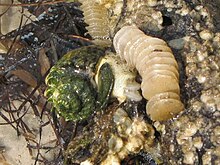American crown snail
| American crown snail | ||||||||||||
|---|---|---|---|---|---|---|---|---|---|---|---|---|

Melongena corona , half buried in the sand |
||||||||||||
| Systematics | ||||||||||||
|
||||||||||||
| Scientific name | ||||||||||||
| Melongena corona | ||||||||||||
| Gmelin , 1791 |
The American crown snail ( Melongena corona ) is a species of snail from the Melongenidae family that lives in the western Atlantic .
features
The right-hand wound shell of Melongena corona , which in adult snails reaches a length of 12 cm, has a low thread and a large body circumference, which, like the other circumferences at the top of the seam, is covered with pointed, upwardly oriented conical teeth, which are the Give the shell the typical crown shape. The periostracum is thick. The thick, horny operculum is claw-shaped with a terminal core. The shape and especially the color of the housing can vary widely. The glossy surface is brownish-gray to purple in color and is usually marked with wide, spiraling white to yellowish-white stripes.
Occurrence
The American crown snail is found in the western Atlantic and Caribbean from Florida and Alabama to South America .
It lives in the intertidal zone , mostly on sandy ground.
Life cycle
Like other new snails, Melongena corona is sexually separated, with the females being slightly larger than the males. The male mates with the female with his penis . The females attach their band-shaped clutches with about 6 to 20 egg capsules to a solid substrate, which can be a stone, rock, the shell of a living or dead animal, a mangrove root, wood, seagrass or an artificial object. The embryos live on stocks of yolk. The development of the Veliger stage largely takes place in the egg capsule, so that metamorphosis to the finished snail takes place before hatching or after only a short pelagic phase.
nutrition
American crown snails are carnivores and scavengers . The main prey species are mussels and small snails , including the beach screw Littoraria irrorata . A significant influence on the mortality of oysters on the Florida coast could not be proven , unlike some typical predatory snails of the region such as lightning snail ( Busycon contrarium ) and apple spiked snail ( Murex pomum ). This leads to the assumption that dead, weakened and dying animals are preferred as food.
Individual evidence
- ↑ Ralph R. Hathaway, KD Woodburn (1961): Studies on the Crown Conch Melongena corona Gmelin . Bulletin of Marine Science, 11 (1), pp. 45-65.
- ↑ Unpublished MS Thesis by KA Hayes (2003, University of South Florida): Phylogeography and evolution of the Florida crown conch (Melongena corona) , 201 pages and unpublished MS Thesis by JJ Loftin (1987, Florida State University, Tallahassee): The distribution of Melongena corona (Gmelin 1791) egg capsules in North Florida , 101 pages, both cited by J. Masterson (2008): Smithsonian Marine Station at Fort Pierce: Melongena corona (Crown Conch) .
- ^ Paul V. Hamilton (1976): Predation on Littorina irrorata (Mollusca: Gastropoda) by Callinectes Sapidus (Crustacea: Portunidae) . Bulletin of Marine Science 26 (3), pp. 403-409.
- ↑ Ralph R. Hathaway, KD Woodburn (1961): Studies on the Crown Conch Melongena corona Gmelin . Bulletin of Marine Science, 11 (1), pp. 45-65.
literature
- Edward E. Ruppert, Richard S. Fox: Seashore Animals of the Southeast: A Guide to Common Shallow-Water Invertebrates of the Southeastern Atlantic Coast . University of South Carolina Press, Columbia (South Carolina) 1988. Crown Conch, Melongena corona : pp. 113f.
- Robert Tucker Abbott, Percy A. Morris: A Field Guide to Shells: Atlantic and Gulf Coasts and the West Indies . Houghton Mifflin Harcourt, Boston 2001. Crown Conch, Melongena corona (Gmelin, 1791) : pp. 226f. ISBN 978-0-618-16439-4 .
- John W. Tunnell, Jean Andrews, Noe C Barrera, Fabio Moretzsohn: Encyclopedia of Texas Seashells: Identification, Ecology, Distribution, and History . Texas A&M University Press, College Station (Texas) 2010. 512 pp. Melongenidae : p. 222.
